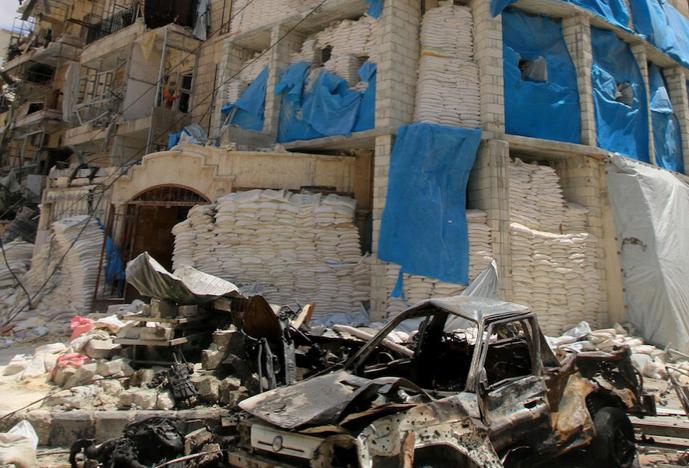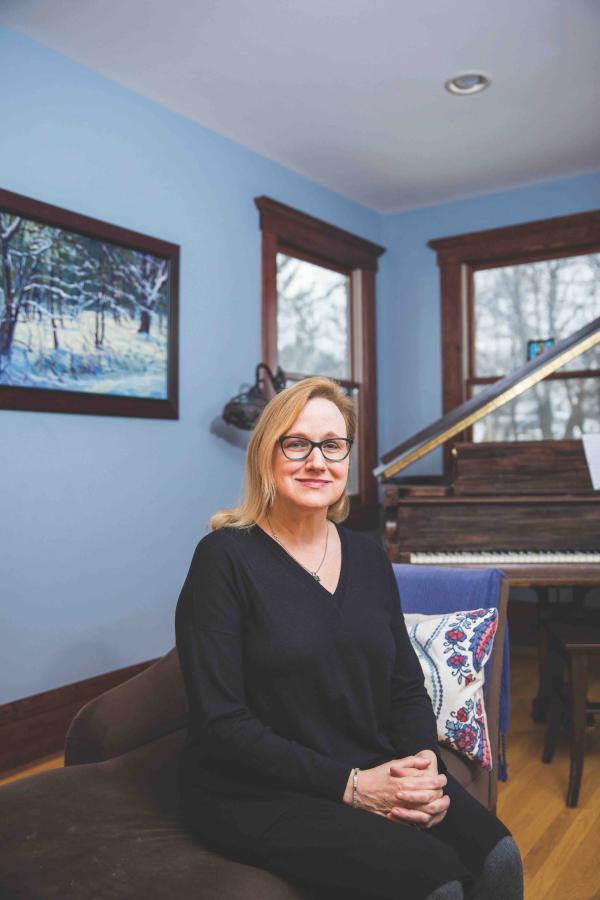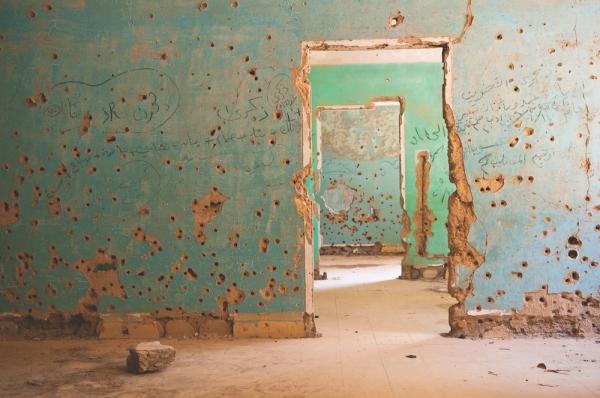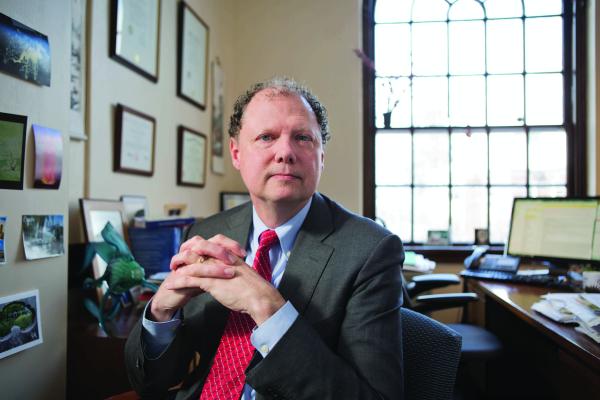
The al-Quds hospital in the opposition-held sector of Aleppo was hit by air strikes in April 2016, killing twenty-seven people, including three doctors. Its destruction left only three functioning hospitals in that part of the city.
She listened quietly as the physician seated near her spoke.
“When the bombs fall, we all mobilize. We know we may die, but we set protocols for what we need to do. We get down to the basement and immediately do triage of the patients who have been injured.
“But afterward, we sing, and talk, and laugh. We remind ourselves that we’re human, and that we’re in this together.”
In late July 2015, Michele Heisler ’97 met with the speaker, a Syrian doctor, and twenty-three other health care professionals who were attending a conference in southeastern Turkey. She had traveled from Michigan to research the current health situation and the possible targeting of medical personnel and facilities by Syrian government forces in east Aleppo.
The conference that served as the focal point for her efforts was sponsored by the Syrian American Medical Society (SAMS), an organization of U.S. physicians of Syrian descent that has been active in providing aid and support to medical personnel in that country since its civil war began in 2011. The meeting included sessions on the harrowing work physicians faced daily as they cared for residents in east Aleppo, then held by forces opposing the government of Syria’s president, Bashar al-Assad.
Some SAMS members, like Chicago-based Samer Attar, traveled several times to Aleppo to spend weeks working beside Syrian doctors, nurses, and other care providers. Other members, such as Pittsburgh-based Ahmad AlhajHusain, set up telemedicine networks to provide counsel and support to those working in hospitals and medical centers in besieged Syrian cities.
A bred-to-the-bone need to deliver humanitarian care drove these physicians to become involved in the Syrian conflict. Yet they were equally compelled by the need to provide community, continuity, and touchpoints of normality to peers who were being pushed to their physical and psychological limits. Like so many physicians who come to the aid of their peers, these doctors are part of the connective tissue that supports and protects those who practice medicine throughout the world.
All Our Yesterdays
The siege of east Aleppo ended in December 2016, but six years of escalating conflict inflicted scars that deepened daily and will likely remain for generations. According to international monitoring groups, the evidence for crimes against humanity there is unequivocal.

Physicians for Human Rights (PHR), an organization that “uses science and medicine to stop human rights violations,” the group that Heisler represented when she conducted her research in Turkey, monitors and investigates violations of medical neutrality; that is, the noninterference with medical services in conflict zones. Heisler, a professor of internal medicine and of health behavior and health education at the University of Michigan, began working with the group in the early 1990s when she was a student at HMS. She is now a member of its board of directors. The organization, a co-recipient of the 1997 Nobel Peace Prize, was founded in Boston in the late 1980s by, among others, Carola Eisenberg, then HMS dean of student affairs, and Robert Lawrence ’64, who was then the chief of medicine at Cambridge Hospital.
As a result of its watchdog efforts in Syria, PHR documented 400 attacks on 276 medical facilities between March 2011 and July 2016. These attacks took the lives of 768 medical personnel. The ramifications of those losses on doctor-patient ratios were vividly portrayed in Aleppo: In 2010, there was one physician for every 800 people; by 2015, that ratio had changed to one for every 7,000 people.
“When we started this work in Syria,” says Heisler, “we assumed hospitals were collateral damage, that they didn’t mean to hit these civilian facilities. But over the years, a number of factors made PHR experts think these were direct attacks.”
“For one,” she adds, “the hospitals were clearly marked as hospitals, markings that would be visible to bomber pilots. Second is the fact that there were times the military announced it would target a hospital—and did.”
Band of Brothers
These overt actions destroyed medical equipment, supplies, and facilities. By late 2015, according to the report Aleppo Abandoned, which Heisler co-wrote for PHR, east Aleppo’s original thirty-three hospitals had diminished to ten, which needed to serve a population then estimated at 250,000. Hospitals were not the only item in short supply. In Heisler’s report she noted there were only two functioning dialysis clinics, few to no ICU beds in each hospital, and no working CT or MRI machines. Inventories of medicines, syringes, linens, and other supplies were likewise inadequate.
Her report also stated that in 2015 Aleppo had about seventy-seven surviving specialists. This number included one neurologist, one cardiologist, and one thoracic, one renal, and one plastic surgeon; two neuro- and two vascular surgeons; and approximately eight general surgeons.
Although Attar, an assistant professor of orthopaedic surgery at the Feinberg School of Medicine, and other physicians from the United States and elsewhere would periodically augment rosters, Syrian doctors increasingly delivered care that was well outside their specialties. Fortunately, support, guidance, and advice for Syria’s care providers could often be found on the other end of an electronic connection.
Tempest in My Mind
About three and a half years ago AlhajHusain, a pulmonologist in the Allegheny Health Network, helped launch a telemedicine effort to support care providers in a small number of hospitals in the Syrian cities of Daraa, Idlib, Aleppo, and Damascus. Starting with four physicians, the network now includes twenty-five doctors in such specialties as radiology, general surgery, neurology, pediatrics, and infectious disease. The Damascus hospital was the first helped by network members. That hospital, like others, was being run by medical students.
“Some of them had never seen a patient,” says AlhajHusain. “When we first contacted them, we saw them managing a ventilator machine using settings we never use. It was all wrong, a lot of mistakes.”
Over the years, the volunteer network has responded at all hours to texts or calls from medical students, nurses, and even physicians who call seeking guidance.
“We see cases that are very difficult, very hard to manage,” says AlhajHusain. “A lot of times, they don’t have the medication that’s required or the necessary technology. We really have to go back and rely on old medical knowledge to manage cases for which we have no testing.”
AlhajHusain’s group keeps the communication bridge open using inexpensive cameras, social media applications such as Viper and WhatsApp, and, when available, computers and tablets. Mobile phones, however, are the principal tools for consults—and teaching.
“In the hospitals that are run by students, we hold a teaching round every day,” he says. “We discuss cases and give advice. We teach the students because eventually they will need to do this themselves.”
Out, Brief Candle
The seemingly unending suffering that fills the days and nights of care providers in Syria has taken a steep psychological toll.
Says AlhajHusain, “Picture this: you’re a second-year medical student. You had a plan to graduate and practice medicine, and now that is all gone. Many times, the students go silent, so we have to speak to them, ‘Okay guys, what’s going on?’ They tell us, ‘I’m in a besieged area, I have no future, I have no degree. I have no life.’ ”

“We reassure them that the work they are doing is important,” adds AlhajHusain, “that they are heroes to the Syrian people. We have to keep them going. If we disconnect from them, what’s that going to do to them?”
Attar has witnessed similar anguish in the physicians he’s worked with. “The surgeons,” he says, “have told me that they’re exhausted. They’re sick of seeing children blown up, of seeing all of this death and suffering. But they do their utmost not to show that they’re exhausted emotionally and mentally. They feel they have to put on this face of hope for their patients.”
“Yet,” he adds, “when you see people bleed to death in front of you every day, and there’s little you can do except hold their hand, watch them die, and put them in a white shroud for burial, I can tell you that it is emotionally and mentally damaging.
“You can see in their eyes that they’re hurting.”
To somewhat mitigate these physical and emotional effects, hospitals and medical centers began mandating periodic time outs for physicians, yet many struggled with complying.
One of the physicians Heisler interviewed explained. “I realized I had to take those breaks because I was losing empathy. I was doing surgery and didn’t have anesthesia. But I was not being sensitive to the pain I was causing. I was getting too hardened. I had to replenish myself so that I could be a caring physician.”
According to Heisler, the physical and emotional pressures Syrian physicians and other health professionals have faced for so long could set the stage for an epidemic of post-traumatic stress disorder (PTSD).
“When they’re under siege, they’re able to keep going,” Heisler says, “but after it’s over, that’s when the vigilance, the nightmares, the flashbacks could start.”
Attar, likewise, thinks the trauma of working through years of siege will affect physicians. “They haven’t had time to process it enough. It could consume and overwhelm them.”
Slings and Arrows
Research on the psychological effects that intense, stress-filled trauma care has on health care providers often focuses on first responders, trauma surgeons, and emergency physicians who work in tertiary hospitals and other care delivery settings, usually in regions of conflict. Studies conducted during the past decade, however, have suggested that more than 15 percent of all physicians experience levels of work-related stress that prevent them from discharging their professional responsibilities. Among first responders, the prevalence of PTSD is tenfold greater than that found in the general population and is equal to that seen in military combat veterans. In a 2014 paper reported in the Journal of Trauma and Acute Care Surgery, researchers showed that, in a survey of more than 450 trauma surgeons in the United States, PTSD symptoms were present in 40 percent of the respondents. Another 15 percent met the diagnostic criteria for PTSD.
Circumstances contribute. In the 2014 study, PTSD symptoms were most commonly found in male surgeons operating on more than fifteen cases per month, having more than seven on-calls per month, and receiving fewer than four hours of relaxation per day.
A study published in 2016 in the Scandinavian Journal of Trauma, Resuscitation and Emergency Medicine by researchers at the University of Leiden, reported on results from a questionnaire designed to assess how work-related traumatic events and hectic work conditions affected the incidence of PTSD symptoms and somatic complaints among the nearly 200 Belgian emergency physicians who participated. The researchers found that 14 percent of the participants met the criteria for a clinical level of PTSD. Interestingly, respondents reported that traumatic experiences were highest in situations in which they dealt with the sudden death, traumatic accident, or disease of a young person. Seventy-five percent of those responding had children of their own.
How powerful a psychological blow a personal connection can land was shown in a 2006 study reported in The Journal of Clinical Psychiatry by researchers in Israel. The investigators surveyed more than 200 surgical physicians based in two Jerusalem hospitals to determine whether exposure to victims of terror triggered their development of PTSD. They found that the prevalence of PTSD among participants equaled that seen in all hospital physicians: 16 percent. Yet when they looked specifically at the surgical physicians with PTSD, they found that their illnesses were precipitated not by what they saw at work, but by the terror they had been exposed to in their personal lives. A similar link was found among family practitioners surveyed in 2003 in Bosnia-Herzegovina.
Considering these findings together begins to assemble a picture of what physicians in Aleppo have faced daily for more than five years: long unbroken periods of frequent exposure to trauma cases; the need to care for injured and traumatized children by physicians who may themselves be parents; and terror and trauma in one’s personal life. This confluence of circumstances may well, as Heisler worries, make Aleppo-based physicians a collective index case for an epidemic of PTSD in Syrian physicians.

To Sleep, to Dream
Sorting out the many variables that underlie the development of PTSD has been central to decades of research by Kerry Ressler ’97, an HMS professor of psychiatry and the chief scientific officer at McLean Hospital.
“I think the physician culture is one in which we’re trained to take care of others; trained to be desensitized to death, to the badness of the world; and trained to focus in the presence of stress,” says Ressler. “You get tough by being tough, so historically within the profession, there’s almost an avoidance of the very topic of PTSD.”
Ressler notes that PTSD became formally defined in the 1970s, after the Vietnam War. By 1980, its status as an illness was fixed, meriting inclusion in the third edition of the Diagnostic and Statistical Manual of Mental Disorders. In work published in 2016, however, experts in trauma medicine, psychology, and psychiatry in Lublin, Poland, showed that PTSD symptoms have been documented for at least 4,000 years. The long-ago source they cite describes the anguish and sleepless nights triggered in citizens of Ur at the sight of dead bodies that resulted from the nearly twenty-year siege of their city by Sumerians and Elamites, two ancient civilizations that lived in areas of what are now Iraq and Iran, respectively.
“The first thing people should know about PTSD,” Ressler says, “is that it happens after trauma and is caused by unwanted intrusions of terrifying memories into conscious thoughts, even dreams. The second thing we know is that the more trauma you’ve experienced, the more at risk you are.
“Our research is beginning to explain who is more at risk.”
As reported in 2014 in The Quarterly, the newsletter of the Brain & Behavior Research Foundation, Ressler has shown in mice that different versions of genes associated with fear and stress responses are also associated with abnormalities in the amygdala and hippocampus in the human brain, two regions that play a role in our fear response and our ability to learn. The abnormalities are behavioral—an increased reaction to threat stimuli—and functional—a decrease in connectivity between the two regions. Other research, in human identical twins, has shown that 30 to 40 percent of a person’s risk for developing PTSD is genetic. Genetics, says Ressler in a 2016 editorial in JAMA Psychiatry, may also help explain why only 5 to 10 percent of those who are exposed to severe trauma develop PTSD.
“We know that individuals with PTSD have epigenetic marks in their genome that are different from those in the genomes of individuals who don’t have PTSD,” says Ressler. “These epigenetic markers might be imprinted early in development as a function of childhood trauma and then may later put the person at a higher risk for PTSD if, as an adult, they experience a second severe trauma.”
Treatment for PTSD, says Ressler, can follow basic learning theory and exposure therapy. “PTSD is secondary to the trauma learning, so if you are reexposed to the trauma cues, you may learn to no longer be afraid of them.”
Or, he says, it can follow more psychodynamic and existential models that help the patient reconnect with “one’s sense of self in the world, one’s sense of trust in relationships. Being reintegrated with people is core to recovery. Community cohesion and connectedness are critical.”
In Aleppo Once
AlhajHusain, Attar, and Heisler know how important it is to the physicians in Aleppo to maintain connections with others but also with those things that can help them cling to some degree of normality.
“You have to talk with them,” says AlhajHusain. “We talk with them about their personal lives and their problems so that they feel that someone is with them, that somebody feels for them.”
While in Aleppo, Attar learned that despite all the horror, there was a strong sense of community.
“That was one of the positive aspects of working in Aleppo,” he says. “You knew you were part of a team, that you were part of this greater sense of purpose. You’re surrounded by all these good men and women who are just there to help people and save lives.”
During Heisler’s interviews, a number of the physicians had shared pictures they carried of friends and colleagues who had been killed while providing medical care. For Heisler, it was those pictures that spoke more than words of the need for connection and reconnection.
“There was a sense of isolation,” Heisler says, “the wonder of whether anyone in the world cared about what they were going through. It’s as if they were asking, ‘is there really so much indifference to this horror?’ We were so far from being able to imagine all that they had gone through yet we could look at a picture of their friend—who they named—and make that connection.
“By showing me the photo he seemed to say, ‘This is a person, this was my friend. We had lunch together, we were in the operating room together two weeks ago, and now he’s dead. Please care.’ ”
Ann Marie Menting is the editor of Harvard Medicine magazine.
Images: Reuters/Abdalrhman Ismail (top); David Lewinski (Heisler); Jcarillet/Getty Images; wall translations by Shady Hekmat Nasser; John Soares (Ressler